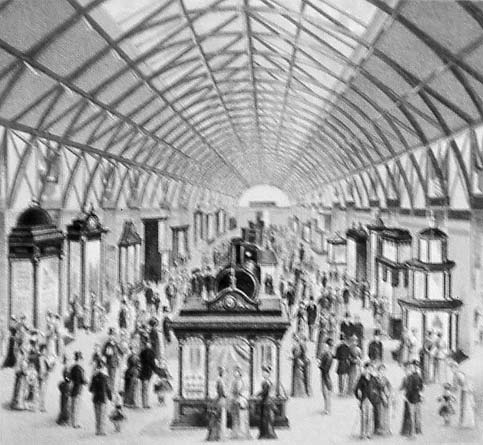
| ||||||||||||||||||||
|
International Exhibition of 1886 The Meadows |
1886 Exhibition - Central Hall
© Reproduced with acknowledgement to The Museum of Edinburgh
|
International Exhibition of Science, Art and Industry |
|
Old Edinburgh Exhibit The 1886 Exhibition was one of several major exhibitions held in Edinburgh in the late-19th and early-20th century. It was held at the Meadows. One of its main attractions was a reconstruction of some of the old buildings that used to stand in the old town of Edinburgh but had been demolished by 1886. Marshall Wane was the official photographer for this feature of the exhibition. He produced cabinet prints and cartes de visite showing several views from the Old Edinburgh exhibit. In the early 1900s, he re-issued these views as postcards. |
|
Still in Edinburgh Several reminders of this exhibition can still be found around Edinburgh, including: 1. The Jawbone Arch at the Meadows. 2. Gateposts featuring about twenty different varieties of stone. These posts still stand at the Meadows, and give a good comparison of how the different stones have survived the Edinburgh weather. 3. A Brass Founders' Pillar, featuring Tubal Cain, a biblical character who was the legendary founder of brass and iron making skills. This monument was commissioned for the 1886 Exhibition by the Edinburgh and Leith Brass Founders. Following the exhibition, the pillar was moved from the Meadows to Nicolson Square where it now stands. 4. The Portuguese cannon now situated on Calton Hill. This was won in the Burmese War, when Burma was added to the Indian Empire in 1886. It was donated by the Government to the City of Edinburgh and displayed in the 1886 Exhibition. *** 5. Attractive large scenes of industry in the 19th century and earlier were produced on tiles for the exhibition (or was it the 1890 exhibition. I'll check.) These can now be found on the walls of the Café Royal, close to the East End of Princes Street. |
|
Portuguese Cannon I think some further research may be needed for item 4 above. After receiving an email from Hew Prendergast asking about this cannon, I searched for Burma cannon Calton Hill on Google. The search brought back several web pages including a page on the RCAHMS Canmore web site which left some doubt about the origin of this cannon, describing it as:
"Cannon on carriage (not original).*
Two symbolic dolphins centre top of barrel, one at end, cast
metal. Coat of arms in cast relief on top of barrel: shield
surmounted by crown with cross at top. Within shield top left:
castle, bottom right: lion, other symbols worn and unclear.
Inscription along side of coat of arms, incised later, possibly
Burmese?" * Should I interpret this comment as meaning that the cannon is original but its carriage is not? Can anybody tell me anything about what happened to the cannon between its capture in Burma (if that's where it came from) and its arrival in Edinburgh for the 1886 International Exhibition? Peter Stubbs, Edinburgh: March 31 +April 1, 2012 |
|
Question 1. Adele Mitchell New South Wales, Australia |
|
Many souvenirs were no doubt produced for sale at the Exhibition. Here is one of them, as described to me in a recent email from Australia. Adele Mitchell wrote: |
|
Question Souvenir "I have a carved ivory cross 4.5 cm long, 3 cms wide and 0.8 cm thick. At the centre of the cross is a removable metal tube 0.5 cm wide and this has a glass cylinder fitted inside it. Now here is the amazing thing. If I look through one end of this glass cylinder I can see 5 black and white photos – like old fashioned postcards – one long with 4 smaller ones underneath that. The heading for these photos is OLD EDINBURGH and underneath is a caption International Exhibition of Industry, Science and Art. 1886." Adele Mitchell, New South Wales, Australia - September 2004 |
|
If you know anything more about this item, please e-mail me so that I can pass on the information to the owner. Thank you |
|
Reply to 1. Leo Macham Bearsden, East Dunbartonshire, Scotland |
|
About seven years after the question above was asked, I received the first reply! It came from Leo Macham who is very familiar with the type of souvenir mentioned above. Leo wrote: |
|
Reply It's a Stanhope "Adele Mitchell mentions a souvenir from the 1886 Exhibition in the form of a cross with a miniature glass image of the exhibition mounted within it. The cross is called a stanhope, also called a peep. The name comes from the lens system used. Combined with a microphotograph, the glass cylinder magnifies the image of about a millimetre in size such that it is clearly visible. Stanhopes were produced in France, first by Rene Dagron in the 1860s. They were sold as souvenirs at most of the major exhibitions, although there are only a few records of stanhopes from the 1886 exhibition in Edinburgh. Bone or ivory crosses were a favourite device for mounting them within. I am a member of a club for stanhope collectors which recently held a meeting in Edinburgh. During this meeting, Graeme Cruickshank gave a talk to us about the 1886 exhibition. I would be happy to supply lots more information on stanhopes if required." Leo Macham, Bearsden, East Dunbartonshire, Scotland: December 10, 2011 |
| ||||||||||||||||||||